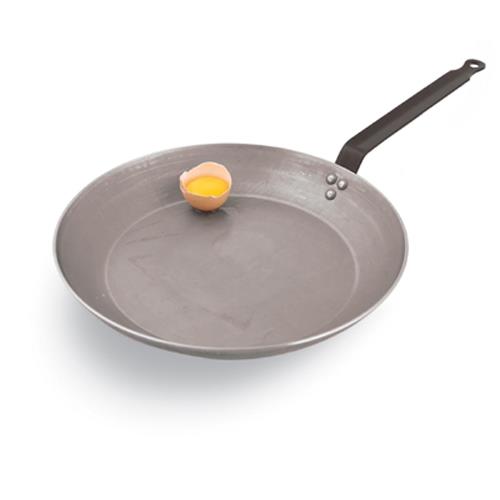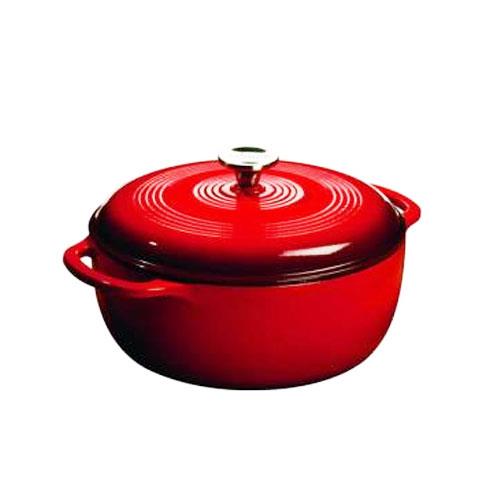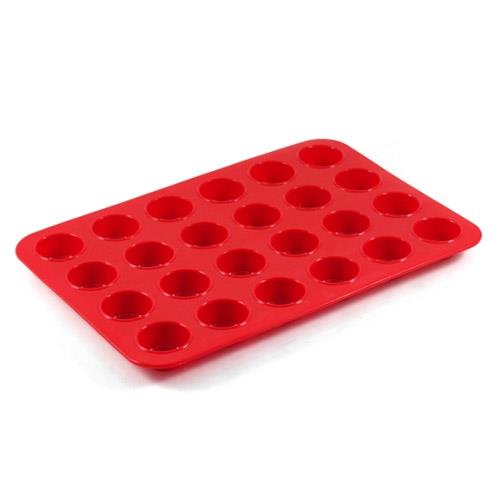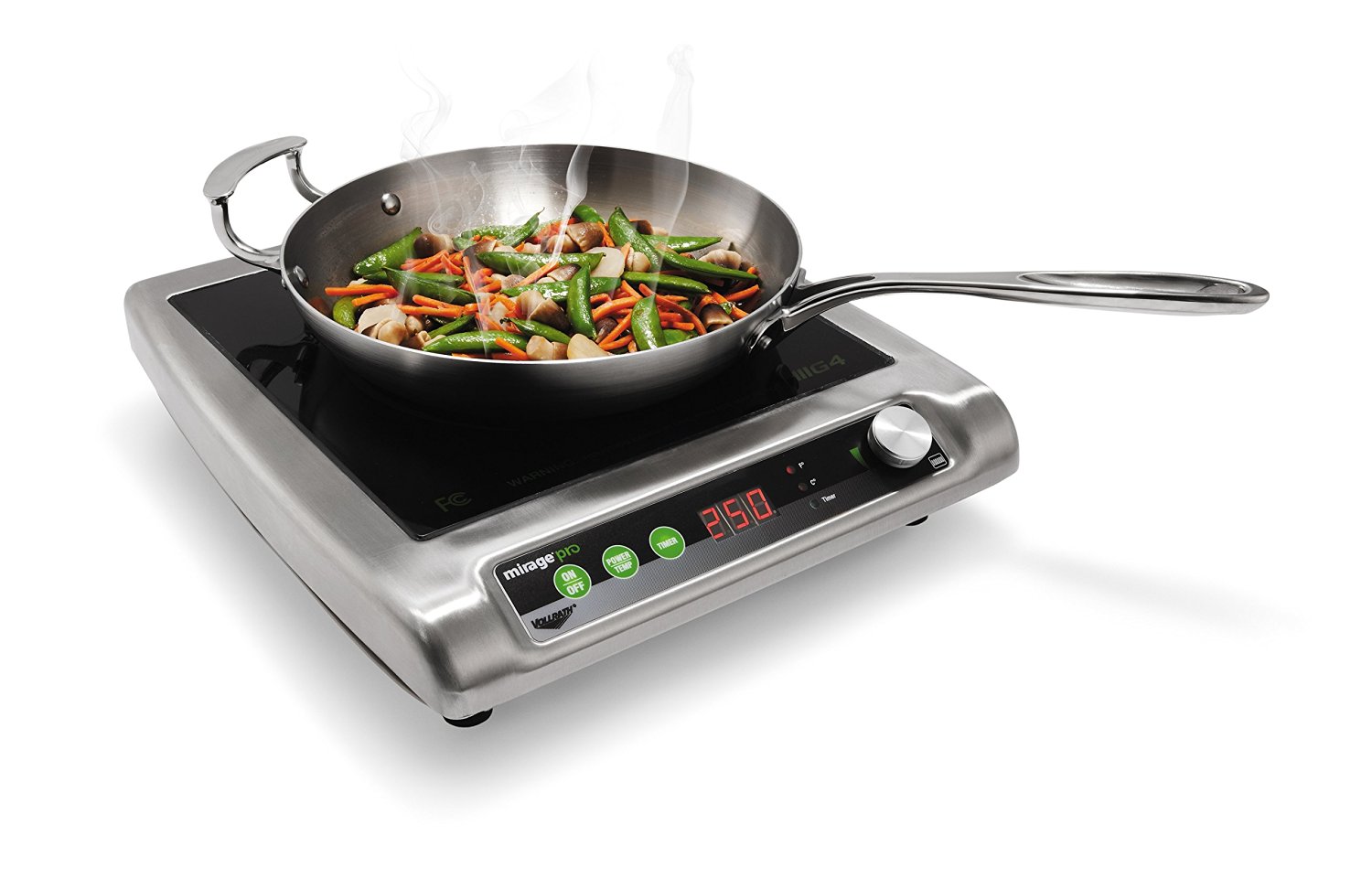As a cook in a commercial kitchen, consistency is key to keeping food costs low and customers happy. Knowing which types of pan materials are best suited to the foods you cook is helpful when creating a good menu. For example, if your restaurant specializes in homemade pasta sauces, I wouldn’t recommend using a cast iron pot.
Read on to learn more about different types of pan materials like cast iron, carbon steel, stainless steel, aluminum and more.

Cast Iron
A tried and true favorite in most commercial kitchens, the unmatched durability and versatility of a cast iron pan makes it popular amongst most chefs. Cast iron is notorious for heating unevenly, but even this can be tackled by letting the pan properly reach temperature before cooking—and once it gets hot, it’ll stay hot! And with a little seasoning your cast iron pan will be nearly non-stick, ensuring you get that perfect sear each and every time. Your cast iron pan can go from range to oven to grill without an issue. That said, iron is a reactive metal, so it’s important to keep your pan seasoned regularly lest you run the risk of flavor transfer and discoloration. In case you’ve been lax in your seasoning schedule, don’t fret. Watch how we restored this garage sale find into a like-new cast iron pan fit for any commercial kitchen:

Carbon Steel
When you love the properties of cast iron but you want a (slightly) lighter option, look to carbon steel. Cast iron contains roughly 2-3% carbon to its 97-98% iron, while carbon steel is composed of roughly 99% iron and 1% carbon. Why does this matter? Less carbon makes it less brittle and thus stronger; it also creates a more uniform grain structure that is more ductile during production. Because carbon steel pans are made from stamped or spun sheets of metal, you’ll also get a smoother surface than its cast iron counterparts. And like cast iron pans, carbon steel pans do well with regular seasoning to prevent rust and create a near non-stick surface (but also like cast iron, avoid making tomato sauces or reducing wine in them). One of the largest differentiators between carbon steel and cast iron pans, however, is the shape of the pan itself. Many cast iron pans feature straight, vertical sides whereas most carbon steel pans have sloped sides that work well for sautéing.

Enameled Cast Iron
Though often found in home kitchens, you may find there’s a good place for enameled cast iron in the kitchen. Featuring the same heating properties and durability as cast iron, enameled cast iron pans are lined with a ceramic enamel that eliminates the need for seasoning. Another perk? The enamel is non-reactive, so cooking acidic dishes like tomato sauce is a breeze. Enameled cast iron pots work well on induction ranges, and I’ve seen this setup used to serve warm hot chocolate to guests on chilly days. These pots are easy to clean and often just require a little soap and water (I don’t recommend putting it in the dishwasher).

Stainless Steel
No stranger to any commercial kitchen, stainless steel is widely known as being durable, dishwasher safe, rust-, scratch-, dent-resistant and so much more. Though prided for its strength, stainless steel is notoriously bad at conducting heat, which is why stainless steel pans often include a layer of aluminum or copper. When it comes to price, aluminum will give you the better deal, but for a little more money you can get a copper-core pan which responds quickly to temperature changes, giving you better control and consistency during the cooking process.

Aluminum
As one of the most cost-effective materials on the market, you’ll find aluminum cookware prevalent in everything from pans to pizza screens, muffin tins and more. On its own, aluminum is extremely soft and reactive (acidic foods like tomatoes don’t do well in aluminum cookware), which is why it’s often treated with a chemical process and mixed with other materials to increase its durability. Aluminum is an excellent heat conductor, so you’ll find it added as layers within many stainless steel cookware.

Silicone
Great for bakers, silicone cake pans, muffin tins, loaf pans and more have become extremely popular in commercial kitchens. Durable and often nonstick, silicone pans are also dishwasher safe so cleanup is a breeze. Silicone pans are great for cakes and other tea breads that don’t require a lot of browning—you’ll get beautiful, consistently-cooked baked treats each and every time!
What does it mean to be “induction ready”?
As induction hot plates find their way into more commercial kitchens, you may find manufacturers wanting to cash in on the popularity by marketing “induction ready” cookware. In some cases, much of your existing cookware is induction-ready to begin with—so how do you know?

Induction works by creating an oscillating magnetic field. Translation? When an electric current in the induction range creates alternating magnetic fields, the molecules in your cookware become “excited” which creates a vibration and generates heat. That means that the induction range isn’t generating the heat, instead it’s the pan itself that’s getting hot. Because there’s little to no heat loss, induction ranges boast as much as a 70-90% energy efficiency over gas and electric ranges, making it one of the most eco-friendly cooking methods on the market.
For a pan to work on an induction range, it simple needs to be magnetic. The quickest way to check if your pan is magnetic? Stick a magnet to it. Pans like cast iron, carbon steel, etc. contain iron which is a magnetic material. Stainless steel on its own is also not magnetic, however there is ‘magnetic’ stainless steel cookware which has iron added to it. Aluminum and copper on the other hand, while being a great conductor of heat, is not magnetic (so steer clear of those aluminum pans if you plan on adding induction ranges to your line).
 Corner Booth Blog | TundraFMP Restaurant Supply, News & Equipment Blog
Corner Booth Blog | TundraFMP Restaurant Supply, News & Equipment Blog



